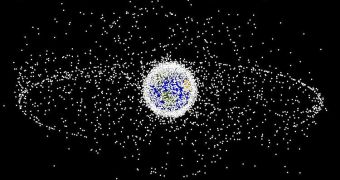The American space agency announces the development of one of the most complex predictive models ever developed in the world, aimed at simulating the potential interactions between spacecraft and space junk for the next few centuries.
The model has been dubbed “low-Earth to geosynchronous environment debris” (LEGEND), and its developers explain that it functions in three dimensions for extended periods of time.
Our planet's orbit is currently clogged with a variety of space junk, including spent rocket stages and related components, dead satellites, payload fairings and debris from spacecraft that have already collided with each other.
Early last year, an American and a Russian satellite collided with each other, producing a massive amount of tiny fragments that are currently zipping past in orbit.
China produced a similar disaster when it tested a laser-based weapons system aimed at proving to the world that it can destroy satellites in orbit. It targeted one of its own spacecraft, which was obliterated, and further littered the orbit.
The issue is less severe in geosynchronous Earth orbit (GEO), but extremely serious in low-Earth orbit (LEO), which is were countless spacecraft carry out their operations.
For the past few years, the shuttle missions have been carried out with extreme caution due to the danger, and NASA mission controllers have reported constantly-increasing flight risks each year.
For the past 24 months or so, the International Space Station (ISS) had to steer out of its stable orbit several time, in order to avoid pieces of space junk speeding past at thousands of miles per hour.
The goal of the LEGEND model is understanding how the situation will evolve from here. It takes into account all possible routes space objects could take, as well as debris that will undoubtedly be produced in future collisions.
Uncertainty and randomness are also accounted for in the model, which is capable of calculating risks factors that may or may not appear in a complex environment such as Earth's orbit.
The results of LEGEND are however not taken at face value. The NASA experts operating it run several simulations at a time, and then base their decisions on the average result.
This helps include the unpredictable in the overall predictions, which basically means that very rare scenarios which may never happen in real-life are also considered, Technology Review reports.

 14 DAY TRIAL //
14 DAY TRIAL //